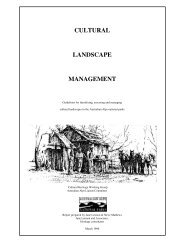Proceedings of an International Year of Mountains - Australian Alps ...
Proceedings of an International Year of Mountains - Australian Alps ...
Proceedings of an International Year of Mountains - Australian Alps ...
You also want an ePaper? Increase the reach of your titles
YUMPU automatically turns print PDFs into web optimized ePapers that Google loves.
Within the Kosciuszko alpine area, early pioneering skiers in the 1950s had received permission from the<br />
Kosciusko State Park Trust to construct Lake Albina Lodge (on the western facing slopes <strong>of</strong> the Lake<br />
Albina Valley) <strong>an</strong>d Kunama Lodge, near Mt Northcote (located between Mt Kosciuszko <strong>an</strong>d Mt<br />
Twynam). Materials for the lodges were tr<strong>an</strong>sported using a bulldozer <strong>an</strong>d sled provided by the Trust,<br />
with the result<strong>an</strong>t track marks still apparent in 2002 (Worboys et al. 1995; authors' pers. obs.). Kunama<br />
Lodge was destroyed by <strong>an</strong> aval<strong>an</strong>che in 1956 <strong>an</strong>d was never reconstructed. Pr<strong>of</strong>essional park m<strong>an</strong>agers,<br />
who had been appointed by the Trust in 1959, recognised that the locations <strong>of</strong> Kunama <strong>an</strong>d several other<br />
proposed lodges were inappropriate, <strong>an</strong>d they prevented the reconstruction <strong>of</strong> Kunama. This was also the<br />
start <strong>of</strong> a new era <strong>of</strong> active pl<strong>an</strong>ning <strong>an</strong>d conservation <strong>of</strong> the alpine area <strong>an</strong>d the park. Following the 1982<br />
Pl<strong>an</strong> <strong>of</strong> M<strong>an</strong>agement process <strong>an</strong>d extensive public consultation, Lake Albina Lodge was removed in the<br />
early 1980s. This was done to prevent further sewage pollution <strong>of</strong> Lake Albina, one <strong>of</strong> the purest fresh<br />
water bodies in Australia <strong>an</strong>d one <strong>of</strong> only five glacial lakes in the highest parts <strong>of</strong> the mountains (Virt<strong>an</strong>en<br />
1993; Worboys et al. 1995). The import<strong>an</strong>ce <strong>of</strong> natural scenery <strong>an</strong>d pure lake water was given precedence<br />
over a recreation facility.<br />
Tourism in Kosciuszko National Park increased in the 1970s with subst<strong>an</strong>tial increases in summer<br />
tourism in the alpine area (Virt<strong>an</strong>en 1993). By the early 1970s traffic jams were common along the old<br />
gravel Summit Road. A proposal for upgrading this road was the “obvious solution”, as was development<br />
<strong>of</strong> a larger car park at Rawson Pass (just below the summit) <strong>an</strong>d a back-up car park at the Snowy River<br />
bridge. Only the Rawson Pass car park was completed, despite the fact that road realignment <strong>an</strong>d<br />
exp<strong>an</strong>sion had been surveyed <strong>an</strong>d pegged ready for construction. Because <strong>of</strong> the congestion, private<br />
vehicles to the summit were b<strong>an</strong>ned during this time, <strong>an</strong>d a shuttle bus system was used to ferry people<br />
from Charlotte Pass to Rawson Pass (Figure 2). The NSW NPWS developed a pl<strong>an</strong>ning discussion paper<br />
for the community in the late 1970s, outlining a different solution (Worboys 1978; NSW NPWS 1980).<br />
Despite some sceptical personal views expressed by several very senior staff members in the park agency,<br />
the public discussion papers advocated a vehicle-free alpine area. There was overwhelming public<br />
support for this <strong>an</strong>d for the closure <strong>of</strong> the Summit Road at Charlotte Pass. This was accomplished legally<br />
in 1982, with the adoption <strong>of</strong> the 1982 Pl<strong>an</strong> <strong>of</strong> M<strong>an</strong>agement. Restrictions on camping in the catchment <strong>of</strong><br />
the glacial lakes were introduced in 1988, in response to degradation <strong>of</strong> the area (Virt<strong>an</strong>en 1993; Figure<br />
2).<br />
Current Tourism In The Alpine Area<br />
In 2002, tourism is the single largest form <strong>of</strong> l<strong>an</strong>d use for the alpine area (Good 1992). It is a multimillion<br />
dollar industry, <strong>an</strong>d supports the economies <strong>of</strong> the principal towns surrounding the park. Tourism<br />
for Kosciuszko National Park has grown from 100,000 visitors in the late 1950s to around one million<br />
visitors in 2000 (Worboys <strong>an</strong>d Pickering 2002b). The small alpine area <strong>of</strong> Kosciuszko National Park<br />
shows a similar trend, with growth in summer visitor use from <strong>an</strong> estimated 20,000 in 1977-78 (Worboys<br />
1978) to 64,000 in 1999-2000, (Johnston, S. <strong>an</strong>d Pickering 2001; Figure 3). At vari<strong>an</strong>ce with these<br />
measures, figures from the chairlift at Thredbo apparently do not show <strong>an</strong> increase in visitor use in the<br />
last decade (Denise Allardice, Kosciuszko-Thredbo Pty Ltd, pers. comm. 2002).<br />
126<br />
Celebrating <strong>Mountains</strong> – An <strong>International</strong> <strong>Year</strong> <strong>of</strong> <strong>Mountains</strong> Conference<br />
Jindabyne, New South Wales, Australia

















